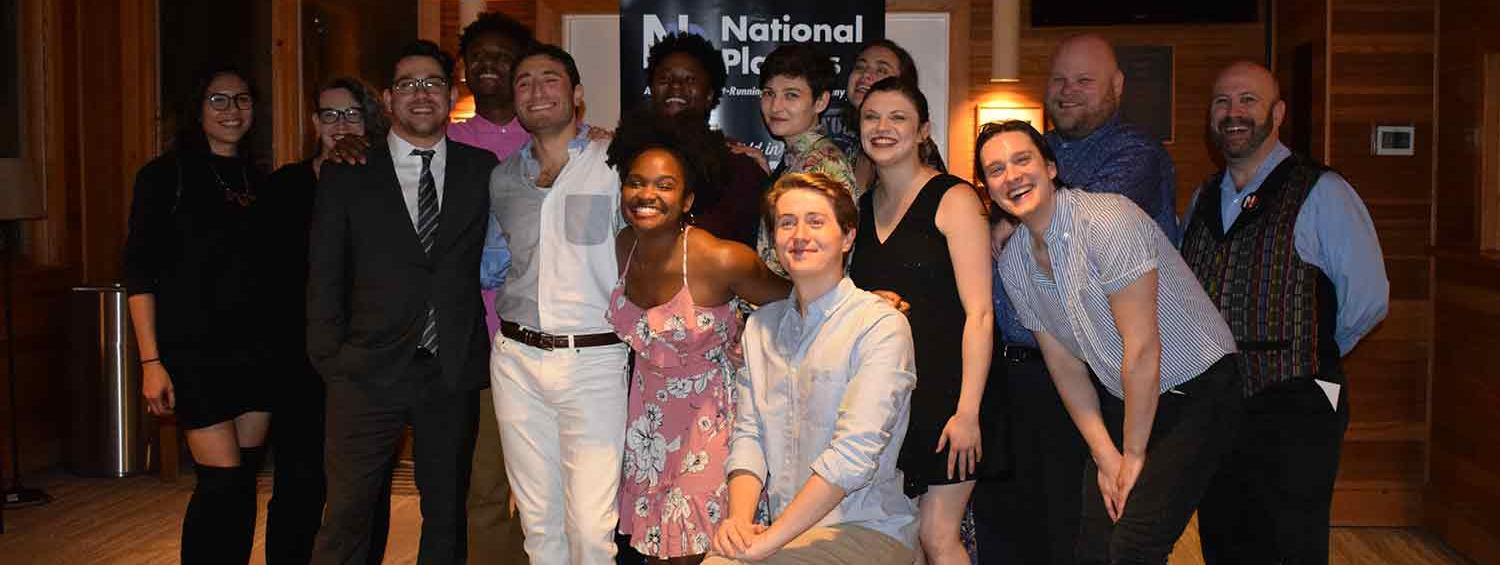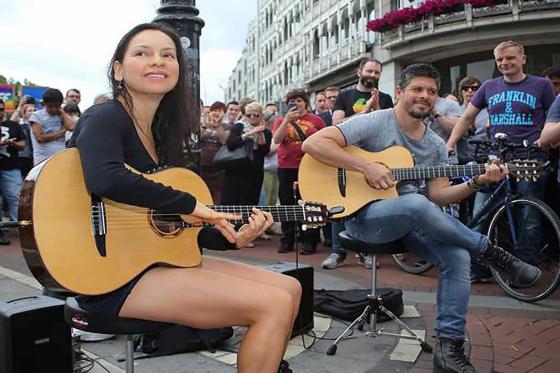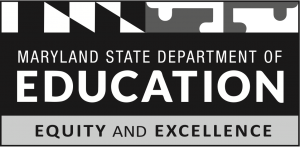Jared Mezzocchi is an amazing theatrical storyteller. He’s a designer, teacher, director, and artistic director. I first got to work with Jared on National Players’ Tour 69 production of Alice in Wonderland that Natsu Onoda Power directed. He provided a ton of expertise and ideas for the use of live video and projections, so when it came to looking for a director for Around the World in 80 Days, Jared was an obvious choice. I wanted to sit down with Jared to ask him some questions but of course he’s busy--currently in Milwaukee designing projections for Junk at Milwaukee Rep--so we chatted via email. Below is my interview with Jared:
jkj. When one thinks of Around the World in 80 Days, one doesn't automatically envision cameras and projections. How did you envision these tools as essential elements for telling the story of Phileas Fogg's unprecedented quest?
JARED. When I read the script I tried to boil it down to one or two main concepts. I found myself intrigued by the question of whether or not we trust Phileas’ ability to do what he claims he can do. I also was intrigued by the idea that because he was so obsessed with winning, he was unable to see what was in front of him: friendship, companionship, love. As a multimedia creator, I was compelled by both of those thoughts and how well they mesh with technology. For instance, we can traverse the world with technology and yet we may get so caught up in it that we lose track of what is in front of us. We also have the ability to use technology to create a fake journey, or create the myth of our lives. You see this mostly through social media.
And so, to me, the use of cameras and projections are sort of embedded in the dramaturgy and DNA of the piece. With this in mind, I didn’t so much have a start to finish idea of the show, but I trusted that the concept of using live cameras to create the myriad of landscapes and transportation could provide the ensemble with enough of a spine to discover what we could do in each scene.
I also saw the climatic moment of Phileas Fogg tearing down the boat in order to fuel the boat to get back to land in time to win as a great opportunity to do the same with the technology on stage. In that moment, we see our protagonist learn what it means to sacrifice everything and take risk. He thinks he may have lost everything, but in fact he gains a new perspective of the world. It is only then, when he strips away technology from his daily life, that he can see the true value of what/who is in front of him. By technology, I mean the 1880s technology used to traverse the world just as much as I mean our performance technology of cameras and projectors.
Jkj. What challenges did you encounter in the rehearsal process that you didn't expect when planning out this production? What exciting discoveries did you make?
JARED. The challenges and discoveries sort of went hand in hand. I always have a concern with using too much technology and therefore getting in the way of the story. And so funnily enough, I overcompensated that by complicating all of the stage pictures with scenic objects everywhere. My fear was that if the show was entirely about technology, it wouldn’t be interesting. And yet! That was what initially excited me about the project! After the first run through and my artistic conversation with Jason King Jones and Jenna Duncan, I was reminded to trust in the concept we originally sought to pursue, because those were the most exciting moments in the play. And so in that final week, we pretty much restaged the show and simplified all of the scene changes. We removed a lot of platform moves and really aimed to trust that the technology (cameras and projector) were enough to tell this story. And in trusting that, it sort of set the ensemble free.
I think one of the initial challenges for me was to teach the ensemble how to use the technology effectively. I wanted them to feel as though the cameras and video mixer and projector were just an extension of themselves. It’s kind of like props, where you need to rehearse with them enough to no longer have to think about them. I see no difference when dealing with interactive technology; you have to rehearse with it enough so that you no longer have to think about it.
Training the ensemble took up the bulk of our first week of rehearsals and required us to just play and find fun and engaging ideas that may or may not make it into the show. While one may see that improvisational rehearsal phase as a deterrence from diving into the show at hand, I saw what great impact that had on the collaboration in that final week of re-staging. I found myself really depending on my actors to think deeply about how the cameras were enhancing their means of communicating to each other. In a way, they had a better perspective of how we could reimagine the scenes because they were in the trenches and could provide me with dramaturgy and tactics of their character.
It was at that point that I fell so wonderfully in love with this ensemble. Their ability to be flexible and view the technology as equally flexible provided a final week of laughter, brainstorming and really exciting growth in the storytelling that we finally landed on.
jkj. Among many other jobs, you are Artistic Director of Andy's Summer Playhouse in Wilton, New Hampshire. How has that experience impacted the stories you tell and the artistic choices you make?
JARED. This is a really good question. I always am asking myself what impact Andy’s has had on my life and career in the arts. Over these past few years, I have grown to love my collaborations with those children (ages 8-18) because they provide me with insight and perspective of humans born and raised within the technological revolution of the post-iPhone culture. In a way, they have more of an ease with technology than I do because it is and always has been second nature to them. So on one hand, Andy’s has provided me a process of working with my ensembles that becomes a conversational environment instead of a “I know how it should be and you will listen.” And that’s just being a good human, so perhaps Andy’s isn’t the only place I learn that… but I do think it demands of me a heightened sense of listening and respect when it is an 8 year old standing in front of you delivering a brilliant idea.
I also think Andy’s has given me an incubator space for innovative ideas. It is a terrifying thing to take risk in the arts. On one hand you want to innovate stories, and innovate the theater community. On the other hand, you need to deliver a clear story. And I think Andy’s is unique because it focuses on new work, provides children a place to grow and develop their artistic palette, and provides a community that wouldn’t otherwise go to theater a space to think deeply about the arts and culture. Because of that, I think the actual product that is promised at Andy’s is for the children of that community to work eye-to-eye with professionals in the field. When we embrace that as our mission, innovation is allowed in a very different way. When we embrace that, the goal is to work eye-to-eye with the kids, so success is found in that…not in the delivery of a perfectly packaged theatrical masterpiece. So our artists, myself included, can strip away their fear and ego when making risks and pursuing really bizarre and unique ideas. Funnily enough, it inevitably leads many choices to be brilliant.
So when I leave Andy’s every summer, I am invigorated with new ideas that I am confident can work and I am confident when pitching the idea because I already have a prototype. This was the case with 80 Days just as much as it continues to be the case with most of my professional work.
jkj. How has working with National Players been different than working with other companies?
JARED. I adored my time working with National Players. It is a hungry and eager group of emerging artists who are ready to leap. I watched as they developed their relationships as artists just as much as characters and I sort of fell in love with that process. I’ve always found it a bit absurd to have to reconfigure your teams whenever you make new work. I’ve always been drawn to the theater companies that are a continued ensemble, like Big Art Group, The Builders Association, or The Wooster Group, and I felt that sense of community when walking into that room every day for rehearsal. Wouldn’t it be silly if The Beatles wrote Abbey Road and then they auditioned for a new band to form when recording Let it Be? Yea, that’s right, I’m comparing the Beatles to National Players.
But in all seriousness, there is major value in holding an ensemble together over the course of several productions. It demands the ensemble to learn each other as theater artists, and not just one character. And I really admire that and was incredibly grateful to be a part of that for even a brief moment in the year.
jkj. What's your favorite food?
JARED. New England Lobstah.






